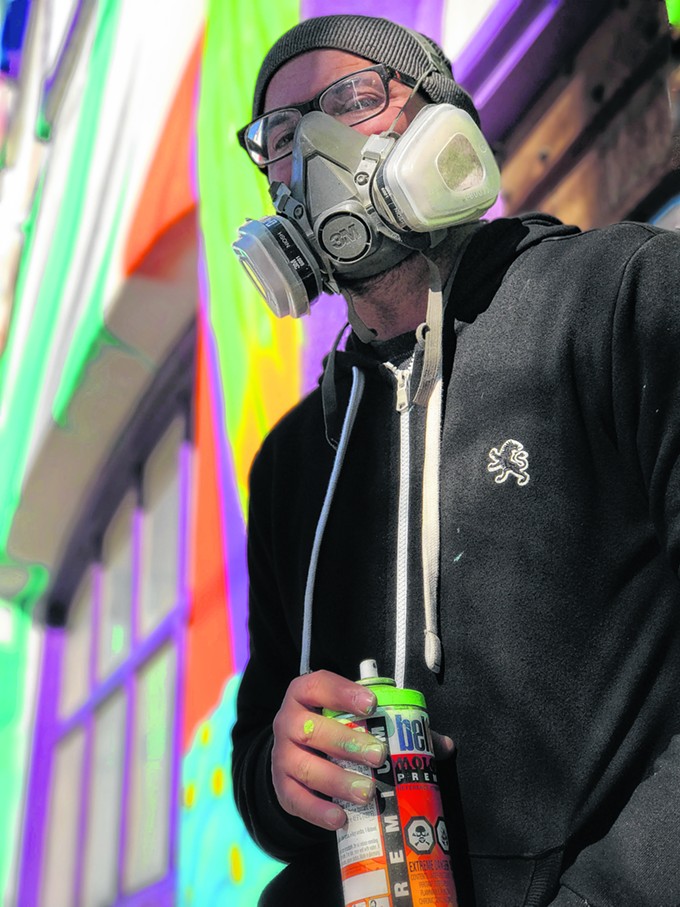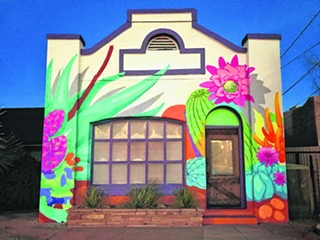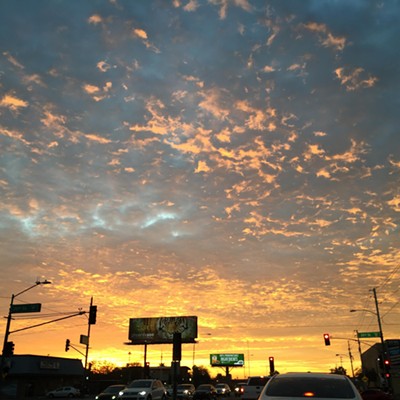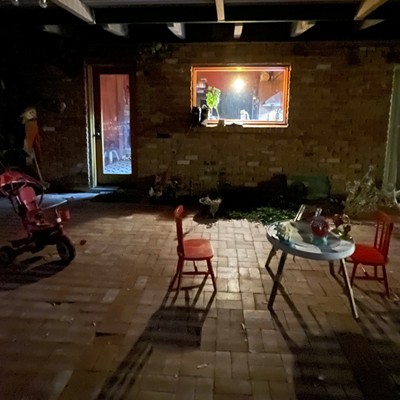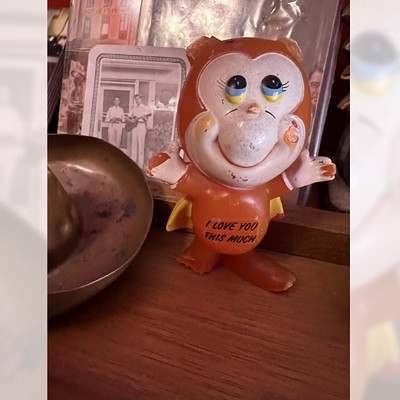When Beyoncé pimps your work on her socials and when Apple appropriates your imagery, you're into a heightened cultural pop lexicon.
It's what happened after muralist/graffiti artist Rock "Cyfi" Martinez created a Prince mural on red brick in Minneapolis last year and pics of it went viral. He'd said his purple-hued, white dove stunner—done in street-weaned spray-can art—was "a gift to Minneapolis." It certainly was. He remembers turning around at one point while he was working on it to a sea of people watching him, like some global DJ. Pop star on pop star. "It was insane."
Clearly Martinez is uncomfortable talking about this. Not the work — he grew up a Tucson b-boy, and Prince (and Michael Jackson) were two of his main musical figureheads as a kid — more the whole idea of a graffiti artist as a star.
Graffiti is about anonymity by tradition partially because it's mostly illegal. No matter how evolved an artist, or how much adoration is showered upon him, Martinez says emphatically that he "lets the art speak for itself. There are already way too many people with their bullshit selfies ..."
He nods to the nearly completed mural he's working on down Stone Avenue in Tucson, which he calls Electric Desert, and explains his work in two simple sentences: "As a graffiti artist, letters are the most important. This is graffiti without the letters." It has the feel of something vital. Something that counts.
It's a Thursday afternoon and Martinez stands in a middle lane of Stone Avenue. There's a rare afternoon lull in traffic. He wears Nikes, zip-up sweatshirt, jeans, a four-day growth and black-rimmed specs. The bright desert flora in his mural pulls his attention, how it’s dulled in bleak afternoon sun, and he tilts his head slightly to some internal dialog. He shakes the spray can, and says, "You're gonna flip."
He bounds back over the curb to the sidewalk and scales the ladder. With exacting precision, he sprays trails of gray tones onto the mural surface. The paint’s all briny and sweet before the wind takes it. His work is rhythmic, he’s consumed by it, yet he talks of grace of "long Arizona shadows," and how if you take time to discover them you'll see this city and desert differently. A minute later and he hops from the ladder, steps backward to the curb, and, as a city bus whooshes within inches of his head, he says, "See?"
I do kind of flip. The Spanish-colonial façade of this old flower shop built in the '30s, which is part of Plants for the Southwest nursery, is utterly transformed. It's illusionary; the shadows Martinez just added are unnoticeable unless you look specifically for them, but new depth is certain.
It's realism on a lovely, deliberate frieze. Such touches are Martinez hallmarks.
He darts across the street for another angle. "Booyah!" he shouts. Then he begins talking of triadic colors and personal palettes, which I ignore because the work gets me.
This colorful collage involves bright, psych-out desert succulents and flowers, a skull, a black widow, agave, saguaro, even peyote. Like other Martinez murals in Tucson, it offers spectacular little vortexes of light, or the impressions of light, which Martinez creates off stems and tentacles with shadows. They soothe yet sort of soar from the concrete three-dimensionally.
The heft and subtle strength shows why Martinez is so damn desirable, in Tucson and all over the country, and, lately the world. This particular mural was commissioned by the nursery, and co-owner Gene Joseph tells me they gave Martinez little guidance, because "they wanted him." Fans of his work.
People who don't know him fall in love with his art. He averages three commissions from each mural. Owners of the Shift Performance car tune up joint across from the nursery hit up Martinez while watching him work. They want a mural to grace three up-sliding industrial doors. Martinez is so busy he'll likely decline what would be a lucrative offer. The artist is flying to Philadelphia in a week, and then Paris and then North Dakota. He's got one due for the City of Tucson too, and an art show in Minneapolis, "inside where the Prince mural is." And, he recently returned from Mexico, where he was invited to represent the U.S. to paint graffiti there.
* * * *
Martinez' work isn’t "street art" — that overly branded, Madison Avenueized splash used to sell everything from burgers to cars — and he's careful to make the distinction. It’s about the art, man. "That's why you have people pulling Banksy's off walls," he says. "I don't hate Bansky. I hate Banksy followers. Or some mural artist who puts his name on his T-shirt. That shit is the wackest fucking shit because you're promoting who you are, you're not promoting what you're producing."
His murals and the field of graffiti arts is similar to filmmaking. Because film studies have been around so long everyone's a genre expert. Highly literate auteurs are able to reference countless on-point filmatic allusions to the giants who've come before, but are also trapped by the rules — whether they follow or defy them — and recent releases are telling: John Wick 2 with action, Nocturnal Animals with noir, Split with horror, La La Land with musical.
Martinez' work is rich in tradition: In the post Exit Through the Gift Shop world where Haring and Basquiat and Banksy are household names, graffiti artists face the kind of dilemmas of following or defying, or at least acknowledging in some way the innovators who came before. Martinez understands this, struggles with the illegal/ethical aspects of tagging but understands how it beautifies. Like Haring, Basquiat and Banksy, he struggles with the celebrity aspect.
Graffiti DNA is New York City and subways; it's black America, not ancient Greece. His reveals bits of Mexican mural art too, tracing back to the '20s, when murals were created with messages to be understood by underprivileged populations. Martinez is a graffiti artist by tradition and proud of it. He knows the rules well enough to push beyond them.
The boyish 36-year-old has been graffiting long enough — and he's skilled enough — so he’s not pretentious-sounding talking work. But he takes it seriously.
He's articulate in an autodidactic way. Super self-aware and picks up on my next question sometimes before it’s asked. He listens closely, politely, never interrupts. Instantly likeable. He's too sincere to be called out on seriousness; dude's refreshingly unironic. He'd never be so gauche as to talk of his work as "his vision." Laughs and shakes his head at that thought.
His could be a workable antithesis to an on-demand, it's-an-all-me world, of social-media cacophony. Art defines us still, he believes. It must, "now more than ever." He pulls from the world right here. He sweetens harsh in desolation, in places people don’t looking, in desert wildlife and vegetation too, painting the feminine and the soft into unforgiving desert scenes and parables. There's conflict in some imagery; the skulls, black widows, peyote, UFOs (oh, the rich Arizona history). His are often about seeing the undersides, some other narrative not many others see or feel.
His crowning Tucson achievement is its largest mural, the 55-foot tall "Mayahuel (Goddess of Agave)" on Seventh Avenue on the west side of the historic Tucson Warehouse and Transfer building, part of Martinez' “Cactus People” series. Another stunner: the 1,500-square foot Dia De Los Muertos mural of Frida Kahlo and Diego Rivera, south of Mercado San Agustin near Cushing Street.
The self-described perfectionist gravitated young to graffiti writing and art, came up spraying illegally. After getting popped once tagging trains and coughing up $11K in fines, Martinez had to rethink his program.
"I risked everything for my artwork,” he says. “We're out there painting trains, we're out there painting billboards. But we're trying to produce something beautiful, not destroy anything. And if I didn't paint trains I wouldn't know how to do this.
“I might be old-school now,” he continues, “some kids might not respect me, but I'm remaining relevant. I'm old-school because I'm using a spray can. I'm not using stencils or a straight edge. I have no projectors. This is all in the traditional way of painting, and murals. I remain true because I'm not trying to sellout a culture and seeing what I can get for it. I don't have to paint my name for somebody to pay me." He pauses.“If you didn't earn your stripes on the street, you'd get beat up.”
If he suddenly disowned his earned traditions, it'd mess with his integrity, like a great singer resorting to Auto-Tune for the hit.
Martinez avoids talking his fees for legal murals, but says he no longer worries about food on the table and neither does his 12-year-old son Ezekiel. Martinez speaks of his son as often as he talks of his father, which is a lot. Fatherhood's a theme.
If his graffiti was all about getting into the most highly visible areas, he’s now more particular about his locations, and what the images say to a city, to himself, as a father, and a son.
"If my son saw me in jail he would know it's because I was doing something I believed in,” he says. “Tagging is expression. Is it wrong? Yeah. So is driving a car too fast. If I ever get busted doing graffiti, fuck it, I'll take it like a man.”
* * * *
Martinez has certain pride: "I like that I'm deep-rooted Tucson."
Born in Tucson to a white mother and an Aztec and Yaqui dad, Martinez has six siblings, and three more adopted little ones. He credits his old man — a life traditionalist who works blue-collar for the City of Tucson — for instilling in him a work ethic. He’s "the best Martinez there is—he'd give his shirt off his back."
Growing up in Hispanic neighborhoods, Rock (yes, Rock is his birth name) Martinez was mostly a nerdy breakdancer who "drew pictures all the time." Picked on often, he once got tied to an ice-cream truck. "Look, I have a lazy eye, I wear glasses. Weirdos and freaks are my people."
Earlier in the aughts, Martinez brought local kids, gangbangers and nationally known graffiti artists together in Tucson for his yearly Winta Fresh fest (and sometimes corresponding Summer Fresh). Says the city gave him so much shit it wasn't worth it: "I was bringing all these people together for one day to create art. Nobody got shot. Nobody got hurt. Know what I mean? I was doing it for the city of Tucson." Had his own shop too, Art Terrain, and it moved locations before shuttering. One time a drunk driver smashed into it and he never saw a dime. He met artists there who pushed his boundaries, guys like Chris Rush, Titus Castanza, Luis Mena, David Tineo. He taught art to at-risk kids for years in a City of Tucson program. ("Those kids were awesome, and I learned through my teaching.")
He's done countless Old Pueblo murals—from tattoo parlors and flower shops and brewers and walls and sides of buildings. "When Michael Jackson died, I painted illegally on the Dunkin' Donuts/Baskin-Robbins location, I pulled my cans out of my trunk and wrote 'Who's Bad.'"
Then shit got bad. His business dried up, he split with the mother of his son, he got a DUI. He was depressed. With a son to raise and little interest in his art, Martinez bailed for Oakland.
Things changed quickly in Cali. He got a call to do a book cover in Los Angeles, which led to a tour, and soon Martinez was painting for High Times' Cannabis Cup. Soon he was painting murals in Boston, Baltimore, all over the east coast. The lucrative commissions began to roll in. He returned to Tucson and worked. Now he splits time between Minnesota (where his girlfriend Brandi Kole lives) and Tucson where Ezekiel lives with mom.
He's in constant travel mode, commission to commission. We talk Tucson arts and the little money available. City boosters say otherwise, but, in short, Tucson is busted. Martinez says he can't earn enough coin here, not like he can in other places.
He adds, "But I can paint the city. And the world."
* * * *
On the first Sunday evening in March I stroll past Martinez's finished 20' by 40' mural on Stone Avenue. Ideas pop, images I'd missed too. The thing demands attention. A purposefully leaning saguaro of gentle jade calms. Shades of pink and red blend into tips of desert flowers, makes melancholy rise. A green skull tall as a five-year-old with purple shadowed eyes reminds me of Martinez' ideas of the circle of humanity and how his Tucson family lineage traces back to the 19th-century people of Fort Lowell. I think of these things now that I see them, even though I stared long and hard at this mural as Martinez was creating it — him moving with that kind of quickness that only inspiration can dictate.

